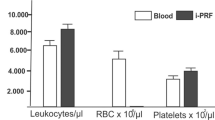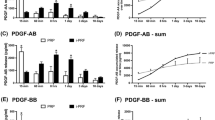Abstract
Objectives
Titanium platelet–rich fibrin (T-PRF), a second-generation autogenous blood concentrate with tough and thick fibrin meshwork activated by a titanium tube, was used as a drug carrier for doxycycline (Doxy) by injection. The objective of this study is to evaluate the loading capacity of T-PRF, release kinetics of doxycycline-loaded T-PRF, and its antibacterial effects against S. aureus and P. aeruginosa.
Materials and methods
The T-PRF and collagen were loaded with Doxy as T-PRF/Doxy and Collagen/Doxy, and their release and antibacterial activities against S. aureus and P. aeruginosa were investigated. Chemical characterization and morphological analysis were performed.
Results
In comparison with collagen, approximately sevenfold more Doxy, 281 mg/g, was loaded into T-PRF. It was found that 25% of the loaded Doxy was released from T-PRF compared to only 12% from collagen within 72 h. The largest inhibition zone diameter (IZD) was observed for T-PRF/Dox with 32 ± 6 mm and 37 ± 5 mm for P. aereginosa and S. aureus, respectively. However, only 10 ± 5 mm and 10 ± 6 mm IZD were observed for bare T-PRF, and no inhibition zone was observed for the Collagen/Doxy group. A dense fibrin structure was visualized on SEM images of the T-PRF/Doxy group compared to the T-PRF group.
Conclusions
T-PRF has higher Doxy loading capacity and long-acting antibacterial effects compared to collagen. T-PRF was shown to have potential autogenous long-term drug-carrying capability for doxycycline. Also, the potential fibrinophilic properties of Doxy were observed to strengthen the structure of T-PRF.
Clinical relevance
T-PRF is an autogenous drug career with high loading capacity and extended antibacterial effects for doxycycline. Doxycycline molecules can be visible on T-PRF fibers. This study suggests that T-PRF/Dox could be used as a proper antibiotic delivery device in the treatments of periodontitis and peri-implantitis.






Similar content being viewed by others
References
Joseph S (2000) Curtis MA (2021) Microbial transitions from health to disease. Periodontol 86:201–209. https://doi.org/10.1111/prd.12377
Hajishengallis G (2000) Lamont RJ (2021) Polymicrobial communities in periodontal disease: Their quasi-organismal nature and dialogue with the host. Periodontol 86:210–230. https://doi.org/10.1111/prd.12371
Sedghi L, DiMassa V, Harrington A et al (2000) (2021) The oral microbiome: role of key organisms and complex networks in oral health and disease. Periodontol 87:107–131. https://doi.org/10.1111/prd.12393
Lamont RJ, Koo H, Hajishengallis G (2018) The oral microbiota: dynamic communities and host interactions
Beck JD, Papapanou PN, Philips KH, Offenbacher S (2019) Periodontal medicine: 100 years of progress. J Dent Res 98:1053–1062. https://doi.org/10.1177/0022034519846113
Szulc M, Zakrzewska A, Zborowski J (2018) Local drug delivery in periodontitis treatment: a review of contemporary literature. Dent Med Probl 55:333–342. https://doi.org/10.17219/DMP/94890
Arweiler NB, Pietruska M, Pietruski J et al (2014) Six-month results following treatment of aggressive periodontitis with antimicrobial photodynamic therapy or amoxicillin and metronidazole. Clin Oral Investig 18:2129–2135. https://doi.org/10.1007/s00784-014-1193-6
Cosgarea R, Eick S, Batori-Andronescu I et al (2021) Clinical and microbiological evaluation of local doxycycline and antimicrobial photodynamic therapy during supportive periodontal therapy: a randomized clinical trial. Antibiotics 10:1–12. https://doi.org/10.3390/antibiotics10030277
Jepsen K (2000) Jepsen S (2016) Antibiotics/antimicrobials: systemic and local administration in the therapy of mild to moderately advanced periodontitis. Periodontol 71:82–112. https://doi.org/10.1111/prd.12121
Hanes PJ, Purvis JP (2003) Local anti-infective therapy: pharmacological agents A systematic review. Ann Periodontol 8:79–98. https://doi.org/10.1902/annals.2003.8.1.79
Joshi D, Garg T, Goyal AK, Rath G (2016) Advanced drug delivery approaches against periodontitis. Drug Deliv 23:363–377. https://doi.org/10.3109/10717544.2014.935531
H.R. R, Dhamecha D, Jagwani S, et al (2019) Local drug delivery systems in the management of periodontitis: a scientific review. J Control Release 307:393–409. https://doi.org/10.1016/j.jconrel.2019.06.038
Steinberg D (2000) Friedman M (2020) Sustained-release delivery of antimicrobial drugs for the treatment of periodontal diseases: fantasy or already reality? Periodontol 84:176–187. https://doi.org/10.1111/prd.12341
Newman, Michael G., Take, i Henry H., Klokkevold, Perry R., Carranza FA (2017) Newman and Carranza’s clinical periodontology thirteenth edition. J Chem Inf Model 53:1689–1699
Ahamed S, Jalaluddin M, Khalid I et al (2013) The use of controlled release locally delivered 10% doxycycline hyclate gel as an adjunct to scaling and root planing in the treatment of chronic periodontitis: clinical and microbiological results. J Contemp Dent Pr 14:1080–1086. https://doi.org/10.5005/jp-journals-10024-1455
Deo V, Ansari S, Mandia S, Bhongade M (2010) Therapeutic efficacy of subgingivally delivered doxycycline hyclate as an adjunct to non-surgical treatment of chronic periodontitis. J Oral Maxillofac Res 2:1–7. https://doi.org/10.5037/jomr.2011.2103
Vega-Vásquez P, Mosier NS, Irudayaraj J (2020) Nanoscale drug delivery systems: from medicine to agriculture. Front Bioeng Biotechnol 8:1–16. https://doi.org/10.3389/fbioe.2020.00079
Tihan GT, Rău I, Zgârian RG et al (2019) Oxytetracycline versus doxycycline collagen sponges designed as potential carrier supports in biomedical applications. Pharmaceutics 11:1–21. https://doi.org/10.3390/pharmaceutics11080363
Mishra M, Mishra B (2012) Mucoadhesive microparticles as potential carriers in inhalation delivery of doxycycline hyclate: a comparative study. Acta Pharm Sin B 2:518–526. https://doi.org/10.1016/j.apsb.2012.05.001
Dohan DM, Choukroun J, Diss A, et al (2006) Platelet-rich fibrin (PRF): a second-generation platelet concentrate. Part II: platelet-related biologic features. Oral Surgery, Oral Med Oral Pathol Oral Radiol Endodontology 101: https://doi.org/10.1016/j.tripleo.2005.07.009
Castro AB, Herrero ER, Slomka V et al (2019) Antimicrobial capacity of leucocyte-and platelet rich fibrin against periodontal pathogens. Sci Rep 9:1–8. https://doi.org/10.1038/s41598-019-44755-6
Egle K, Salma I, Dubnika A (2021) From blood to regenerative tissue : how autologous platelet-rich fibrin can be combined with other materials to ensure controlled drug and growth factor release. Int J Mol Sci 22
Miron RJ, Moraschini V, Fujioka-Kobayashi M et al (2021) Use of platelet-rich fibrin for the treatment of periodontal intrabony defects: a systematic review and meta-analysis. Clin Oral Investig 25:2461–2478. https://doi.org/10.1007/s00784-021-03825-8
Tunali M, Özdemir H, Küçükodaci Z, et al (2014) A novel platelet concentrate: titanium-prepared platelet-rich fibrin. Biomed Res Int 2014: https://doi.org/10.1155/2014/209548
Miron R, Choukroun J, Ghanaati S (2022) Controversies related to scientific report describing G ‑ forces from studies on platelet‑rich fibrin: necessity for standardization of relative centrifugal force values. https://doi.org/10.4103/GFSC.GFSC
Miron RJ, Pinto NR, Quirynen M, Ghanaati S (2019) Standardization of relative centrifugal forces in studies related to platelet-rich fibrin. J Periodontol 90:817–820. https://doi.org/10.1002/JPER.18-0553
Ustaoğlu G, Ercan E, Tunali M (2016) The role of titanium-prepared platelet-rich fibrin in palatal mucosal wound healing and histoconduction. Acta Odontol Scand 74:558–564. https://doi.org/10.1080/00016357.2016.1219045
Sahiner N, Suner SS, Kurt SB et al (2021) HA particles as resourceful cancer, steroidal and antibiotic drug delivery device with sustainable and multiple drug release capability. J Macromol Sci Part A Pure Appl Chem 58:145–155. https://doi.org/10.1080/10601325.2020.1832518
Suner SS, Sahiner M, Ayyala RS et al (2021) Versatile fluorescent carbon dots from citric acid and cysteine with antimicrobial, anti-biofilm, antioxidant, and AChE enzyme inhibition capabilities. J Fluoresc 31:1705–1717. https://doi.org/10.1007/s10895-021-02798-x
Lambs L, Brion M, Berthon G (1984) Metal ion-tetracycline interactions in biological fluids. Part 3. Formation of mixed-metal ternary complexes of tetracycline, oxytetracycline, doxycycline and minocycline with calcium and magnesium, and their involvement in the bioavailability of these an. Agents Actions 14:743–750. https://doi.org/10.1007/BF01978919
Khader H, Solodushko V, Al-Mehdi AB et al (2014) Overlap of doxycycline fluorescence with that of the redox-sensitive intracellular reporter roGFP. J Fluoresc 24:305–311. https://doi.org/10.1007/s10895-013-1331-6
Stoller NH, Johnson LR, Trapnell S et al (1998) The pharmacokinetic profile of a biodegradable controlled-release delivery system containing doxycycline compared to systemically delivered doxycycline in gingival crevicular fluid, saliva, and serum. J Periodontol 69:1085–1091. https://doi.org/10.1902/jop.1998.69.10.1085
Moura LA, Ribeiro FV, Aiello TB et al (2015) Characterization of the release profile of doxycycline by PLGA microspheres adjunct to non-surgical periodontal therapy. J Biomater Sci Polym Ed 26:573–584. https://doi.org/10.1080/09205063.2015.1045249
Cai Z, Li Y, Wang Y et al (2019) Antimicrobial effects of photodynamic therapy with antiseptics on Staphylococcus aureus biofilm on titanium surface. Photodiagnosis Photodyn Ther 25:382–388. https://doi.org/10.1016/j.pdpdt.2019.01.024
Souto R, Silva-Boghossian CM, Colombo APV (2014) Prevalence of Pseudomonas aeruginosa and Acinetobacter spp. in subgingival biofilm and saliva of subjects with chronic periodontal infection. Brazilian J Microbiol 45:495–501. https://doi.org/10.1590/S1517-83822014000200017
Feng M, Wang Y, Zhang P et al (2020) Antibacterial effects of platelet-rich fibrin produced by horizontal centrifugation. Int J Oral Sci 12:1–8. https://doi.org/10.1038/s41368-020-00099-w
Burnouf T, Chou ML, Wu YW et al (2013) Antimicrobial activity of platelet (PLT)-poor plasma, PLT-rich plasma, PLT gel, and solvent/detergent-treated PLT lysate biomaterials against wound bacteria. Transfusion 53:138–146. https://doi.org/10.1111/j.1537-2995.2012.03668.x
Bielecki TM, Gazdzik TS, Arendt J et al (2007) Antibacterial effect of autologous platelet gel enriched with growth factors and other active substances: an in vitro study. J Bone Jt Surg - Ser B 89:417–420. https://doi.org/10.1302/0301-620X.89B3.18491
Miron RJ, Zhang Y (2018) Autologous liquid platelet rich fibrin: a novel drug delivery system. Acta Biomater 75:35–51. https://doi.org/10.1016/j.actbio.2018.05.021
Polak D, Clemer-Shamai N, Shapira L (2019) Incorporating antibiotics into platelet-rich fibrin: a novel antibiotics slow-release biological device. J Clin Periodontol 46:241–247. https://doi.org/10.1111/jcpe.13063
Pillai AK, Thomas S, Seth S, et al (2021) Platelet rich fibrin (PRF) gel as efficient vehicle for local drug delivery in minor oral surgical defects. 185–191
Donmezer CM, Bilginaylar K (2021) Comparison of the postoperative effects of local antibiotic versus systemic antibiotic with the use of platelet-rich fibrin on impacted mandibular third molar surgery: a randomized split-mouth study. Biomed Res Int 2021:1–7. https://doi.org/10.1155/2021/3040661
Xing R, Witso IL, Jugowiec D, et al (2015) Antibacterial effect of doxycycline-coated dental abutment surfaces. Biomed Mater 10: https://doi.org/10.1088/1748-6041/10/5/055003
Acknowledgements
The authors are also grateful to Dr. Süleyman Sami Doğangün and the volunteer pre-graduate students of Canakkale Onsekiz Mart University Faculty of Dentistry for their valuable contribution to performing the study.
Funding
The authors thank Canakkale Onsekiz Mart University Scientific Research Council. This Project was supported by COMU-BAP with Project number TSA-2021–3494.
Author information
Authors and Affiliations
Corresponding author
Ethics declarations
Ethics approval and consent to participate
Approval was obtained from Çanakkale Onsekiz Mart University Clinical Research Ethics Committee (number: 2020/13; date: November 11, 2020) at the beginning of this study. The written informed consent was obtained from study participants.
Conflict of interest
The authors declare no competing interests.
Additional information
Publisher's note
Springer Nature remains neutral with regard to jurisdictional claims in published maps and institutional affiliations.
Supplementary Information
Below is the link to the electronic supplementary material.
Rights and permissions
About this article
Cite this article
Ercan, E., Suner, S.S., Silan, C. et al. Titanium platelet–rich fibrin (T-PRF) as high-capacity doxycycline delivery system. Clin Oral Invest 26, 5429–5438 (2022). https://doi.org/10.1007/s00784-022-04510-0
Received:
Accepted:
Published:
Issue Date:
DOI: https://doi.org/10.1007/s00784-022-04510-0




